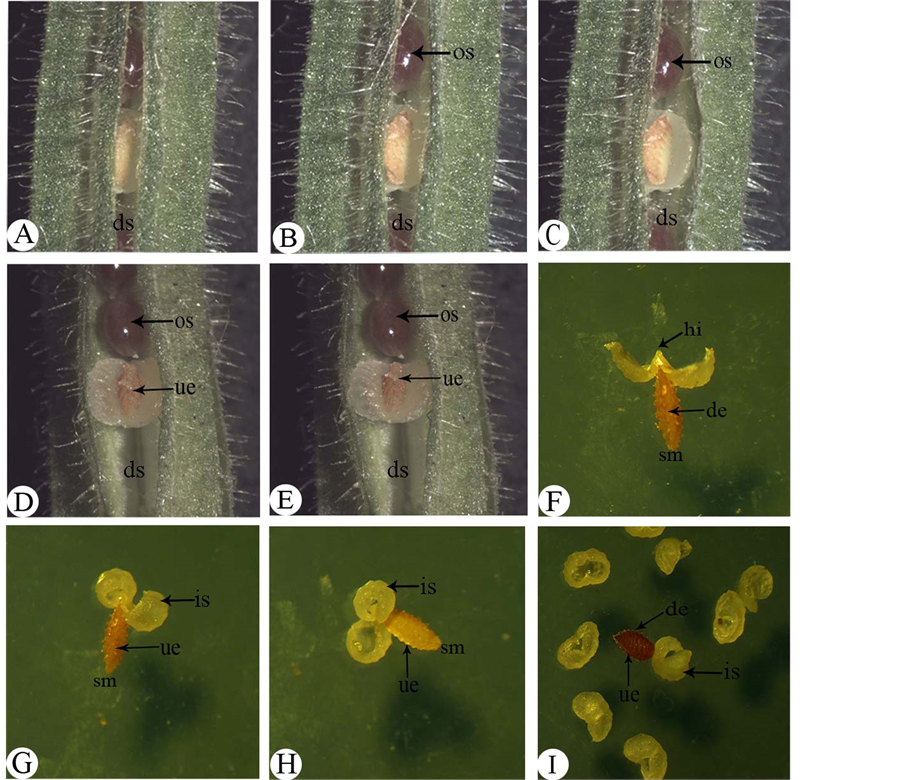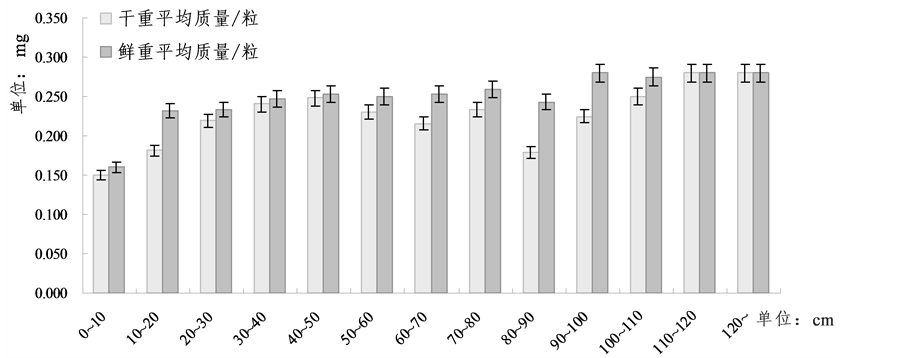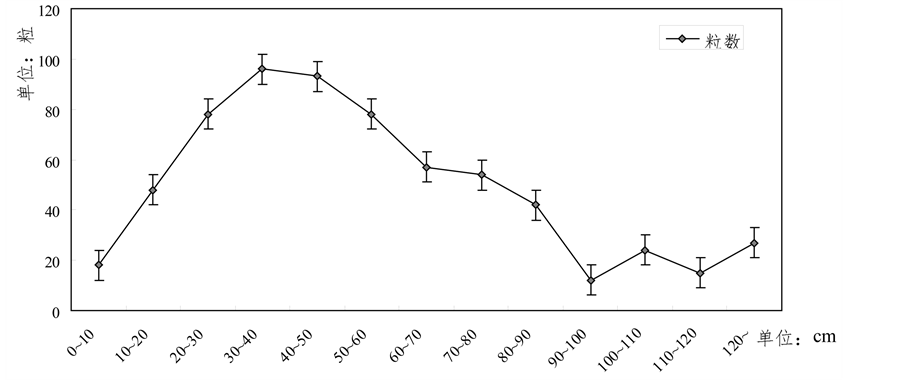1. 引言
酢浆草属(Oxalis L. )植物约800多种,广布全世界,主要分布在中、南美洲和南非, 特别是好望角地区[1] [2] 。中国有酢浆草属植物6种3亚种1变种,其中2种为驯化的外来种[3] [4] 。酢浆草(Oxalis corniculata L.),原产南美,是酢浆草科酢浆草属的一年生草本植物。
近年,对酢浆草的研究主要集中在园艺栽培繁育和观赏价值,酢浆草的化学成分及其药用等方面[5] -[11] 。但关于酢浆草种子的传播特点,尤其是关于种子弹力传播的机制,种子质量与传播距离所涉及的繁殖生物学方面的研究尚未见报道。本实验分别从观察酢浆草果实组织切片,解剖酢浆草果实,探究种子的质量与其弹射距离的关系和种子散布距离与其分布密度的关系三个方面,着重探讨酢浆草种子弹力机制,以期为酢浆草的进一步研究积累基础资料。
2. 材料与方法
2.1. 实验材料
以芜湖市及其周边地区的酢浆草为研究对象,2013年5月份采集幼嫩和成熟弹射后的果实于FAA(Formalin-acetic-alcohol)固定液中保存备用。
2.2. 石蜡切片法
选取幼嫩和弹射后两个阶段的果实若干份于FAA固定液中固定,采用李正理的常规石蜡切片法[12] 制片后在Olympus BX-UCB型显微镜下观察并拍照。
2.3. 室外观察
野外定点定期拍照记录酢浆草果实在各生长阶段的主要变化特点,并观察酢浆草种子弹出时的运动轨迹。解剖成熟的果实并观察并记录其主要特征。人为触碰果实诱发种子弹射,解剖镜下连续拍照记录种子弹射的全程图。
2.4. 种子质量与弹射距离测定
本实验在2013年5月中旬进行,选择芜湖市安徽师范大学校园、神山公园两个样本点,同一时间段内在两个样本点各收集一次,具体方法如下:在成熟的酢浆草果实附近平铺一层白色纱布,然后用手指或笔尖轻轻触动成熟果实的果尖,稍有震动即可诱发弹射。用毫米刻度卷尺测量果实与种子之间的距离,记录数据并将种子收集在相应梯度距离收集器内,梯度距离单位设置为10 cm。将两个样本点收集得到的种子,同一梯度距离内的相混合,分析天平称量各梯度距离下种子的质量,得出鲜重时的平均质量。再置于80℃恒温箱中烘干48小时,同上方法得出干重时的平均质量,计算机辅助绘制鲜重和干重时种子质量与弹射距离关系图。
3. 实验结果
3.1. 组织切片结果
酢浆草果实在幼嫩和成熟后两个阶段有显著变化。幼嫩阶段果皮组织表皮细胞1层,泡状细胞(图1A~C)1~3层,其中在接近背缝线和腹缝线处1层,背、腹缝线之间2~3层,使果皮横切面形状呈山丘形,泡状细胞体积大(50~70 μm),含水量多;内表皮细胞2~3层,细胞体积同表皮细胞相当。假种皮在种子的尖端愈合处也有一排由6~8个排列整齐的泡状细胞(图1C)组成,细胞体积(10~15 μm)比临近细胞大,该结构可能与假种皮的翻卷开裂有关。假种皮细胞4~6层,其中外侧2~4层细胞排列疏松,细胞体积也较大(20~30 μm),内侧1~2层细胞排列紧密,细胞壁呈连珠状增厚,体积与表皮体积相当,细胞含丰富

Figure 1. The paraffin section of young Oxalis corniculata L. (A) Capsule of Oxalis corniculata L. (show pericarp, ×40); (B) Seed of Oxalis corniculata L. (show aril, ×200); (C) Seed of Oxalis corniculata L. (show bulliform cell, ×400); (D) Capsule of Oxalis corniculata L. (show crystal, ×200)
注:mc: 泡状细胞bulliform cell; ar: 假种皮 aril; cr: 晶体 crystal; ov: 胚珠 ovule。
图1. 幼嫩时期酢浆草切片图 (A) 果实(示果皮,×40) (B) 种子(示假种皮,×200) (C) 种子(示种尖泡状细胞,×400) (D)果实(示晶体,×200)
的草酸钙结晶(图1D),内侧和外侧的假种皮细胞的大小和排列方式的差异可能与假种皮的向外翻卷有关。种皮细胞多层,与假种皮细胞排列紧密,但成熟过程中逐渐分离。成熟弹射后阶段果皮(图2A,图2B)变薄,残存的几层细胞皱缩在一起,推测在果实成熟过程中细胞存在失水现象。
3.2. 种子弹力过程结果
酢浆草种子弹力过程研究表明,成熟酢浆草果实的果皮松软,果皮在背缝线(图3A~E)处开裂,部分虽没有明显裂开但在背缝线处已经结合不紧密,果皮开裂可以减小种子弹出的阻力。轻轻触碰成熟的果实,假种皮急剧向外翻卷产生的收缩力,和假种皮在翻卷过程中与果皮相互挤压时产生的相互作用力共同作用,将种子以反弹的形式传播出去。假种皮翻卷时产生的收缩力可人为分解为水平和垂直两个方向,水平方向:假种皮在种尖(图3F~H)处裂开后向种脐(图3F)处翻卷,给种子施加水平方向的作用力;垂直方向:假种皮同样在种子的尖端处先开裂,然后种子上侧棱角(图3G~I)的假种皮比种子下侧棱角(图3F,图3I)的假种皮裂开的更快,翻卷的也更快,假种皮上方翻卷时产生的作用力大于下方翻卷时产生的作用力,导致种子在垂直方向上受到作用力的合力向上。水平向外的作用力与垂直向上的作用力合力与维管柱的夹角为锐角,引起种子斜上抛运动,实际观察发现种子的确是被斜上抛而传播出去。假种皮光滑的外表面(图3B~E)在翻卷后变成内表面,原来粗糙的内表面(图3G~I)在翻卷后变为外表面。大部分种子弹出后假种皮留在果实内或果枝附近,少部分连同种子一起弹出较远的距离。
扫描电镜下的酢浆草种子呈长扁卵行,具有明显的沟嵴状横纹,表皮纹饰有比较规则的不等边六角形或五边形网眼,网眼中间都有1个明显的棱柱状突起,突起上还分布有长的钩状物[13] 。推测沟嵴状横纹、棱柱状突起、突起上的钩状物三者均起杠杆作用,是保证假种皮翻卷时产生的作用力有效传输给种子的媒介。沟嵴状横纹的走向很有规律,推测其也影响种子受力的方向,对种子斜抛运动的形成具有一定促进意义。
3.3. 种子弹射距离实验结果
酢浆草每个果实平均含有种子43(±13)粒,鲜重时0.247 mg/粒,干重时0.225 mg/粒,散布距离一般不超过140 cm。从种子散布距离与质量关系图(图4)看出,种子无论是在鲜重时还是干重时,随着散布距离增加,种子的质量呈波浪式增加,表明种子越重,散布距离越远,且干重时变化的幅度更明显。种子的质量越大,表明种子所贮藏的营养物质相对更多,种子的萌发的活力更强,更有利于萌发生长。酢浆草将活力更强的种子传播到远离母株的地方,不仅大大减缓了种群内部的竞争,还有利于拓展生存

Figure 2. The paraffin section of dissilient capsule of Oxalis corniculata L. (A) Capsule of Oxalis corniculata L. (×40); (B) Capsule of Oxalis corniculata L. (×100)
注:Pe: 果皮 pericarp; vc: 维管柱 vascular cylinder; ss: 种柄 seed stalk。
图2. 成熟弹射后切片图 (A) 果实(×40);(B) 果实(示种柄,×100)

Figure 3. The dispersal process of Oxalis corniculata L.
注:ds: 背缝线 dorsal suture; sm: 种尖 seed mucro; hi: 种脐 hilum; ue: 种子上侧棱角 seed upside edge; de: 种子下侧棱角 seed downside edge; os: 假种皮外表面aril outside surface; is: 假种皮内表面aril internal surface。
图3. 酢浆草种子弹射过程解剖图

Figure 4. The relationship between seed mass and dispersal distance of Oxalis corniculata L.
图4. 酢浆草种子散布距离与质量关系图

Figure 5. The relationship between seed quantity and dispersal distance of Oxalis corniculata L.
图5. 酢浆草种子散布距离与粒数关系图
空间,有利于整个种群的生存繁衍,这是植物在漫长的演化过程中形成的对环境的适应。从种子散布距离与粒数关系图(图5)得出30~60 cm处的最多,占种子总数的41.59%,而在较近和较远种子粒数较少,即种子密度分布随距离增大先增后减,表明酢浆草果实自体反弹传播机制将种子传播更远距离的能力上是有限的。该结果基本符合种子空间传播模型中的准麦克斯韦空间密度分布模型[14] 。
4. 讨论
酢浆草种子弹力传播机制是果皮中体积较大、富含水分的泡状细胞在成熟过程中失水收缩产生的牵引力使果皮从背缝线处裂开,为种子弹出减小阻力。假种皮外侧的泡状细胞在成熟过程中失水收缩,而内侧细胞壁呈连珠状增厚的细胞体积小、含水量少,成熟过程中失水收缩相对小得多,假种皮内外侧收缩不均衡积聚的扭转力达到一定势能,越过能障,引起假种皮急剧向外翻卷,将种子以反弹形式斜抛出去。假种皮损坏的种子不能进行有效传播,表明假种皮是保证种子传播的关键结构。反弹传播机制与细胞膨胀传播机制和爆裂传播机制的原理基本相通,支持和发展了细胞膨胀传播和爆裂传播的内容。酢浆草的自体传播方式相比于气流传播或动物传播等被动传播方式,种子进行有效传播的距离大大缩短。生物在长期的选择进化中,为了减缓种内竞争带来的负面影响,母株有将更饱满、更有生命力的种子传播到更远的趋势,但由于自身结构等多种因素制约,种子被弹射出去的距离还是有一定限度的。本实验对酢浆草种子弹力传播机制的初步探究,仍然存在一定的局限性。成熟阶段酢浆草果实的组织结构与更弹射时的结构更相似,但成熟阶段的果实极易爆裂,无法得到成熟阶段果实的组织结构。温度、湿度和风速等条件对种子的弹射传播都有一定影响,不同环境条件下收集得到的数据可能略有差异,具体差异规律还有待进一步探讨。
种子传播是当今进化生物学、保护生物学和恢复生态学的研究热点之一,近年来发展迅速。很多研究已经证明,种子的传播方式对种子库的数量规模和空间分布动态影响很大,但是迄今为止对种子传播机制的研究并不深入,种子传播的过程、经过传播后种子的命运,以及种子适应各种传播途径的机理等方面的研究都较少,而且对种子传播的研究着重于结果,对其传播过程了解不多[15] -[18] 。本实验通过自体传播方式中的优良实验材料——酢浆草种子弹力传播机制的研究,为种子传播生物学研究提供了支持。酢浆草种子弹力传播的机制是巧妙而复杂的,脱落酸、乙烯等植物激素在植物生长过程中具有重要的调控功能,诱发种子弹射是否涉及到激素的调控还不清楚,目前也没有相关方面研究的报道,种子弹力传播具体的调控机制,还有待进一步深入研究。
5. 结论
本实验研究表明假种皮是酢浆草种子弹力传播的关键结构,假种皮主要由泡状细胞组成,泡状细胞随着果实成熟而严重失水,不同细胞间因失水收缩不平衡积聚的扭转力,是种子弹射直接作用力,果皮对种子的弹射具有协同作用。种子质量与弹射关系表明弹射距离越远,种子质量越大,且干重时比鲜重时关系更加明显,种子密度分布随传播距离增大先增后减。母株有将更饱满、更有活力的种子传播到更远的趋势,但由于自身结构等多种因素制约,种子被弹射出去的距离还是有一定的限度。
基金项目
国家级大学生创新创业训练计划项目资助。

NOTES
*通讯作者。